To unite generations under one roof, start with a neutral palette for a calming atmosphere. Design shared spaces for interaction, and create personal havens in bedrooms. Choose inclusive and accessible features like wide doorways and non-slip flooring. Incorporate multifunctional furniture and communal dining areas to spark connection. Don't forget safety features like automatic lighting. These tips enhance comfort and efficiency while promoting family bonding. Explore more ideas to create a harmonious environment for everyone.
Key Takeaways
- Utilize a neutral palette to create a calming atmosphere that appeals to all family members and enhances shared spaces.
- Incorporate multifunctional furnishings to keep areas organized and promote interaction among different generations.
- Design personal havens in bedrooms that reflect individual tastes while maintaining a cohesive aesthetic throughout the home.
- Create communal dining spaces to foster storytelling and strengthen family bonds during shared meals.
- Include safety and accessibility features, such as widened doorways and non-slip flooring, to ensure comfort for all ages.
Start With a Neutral Palette
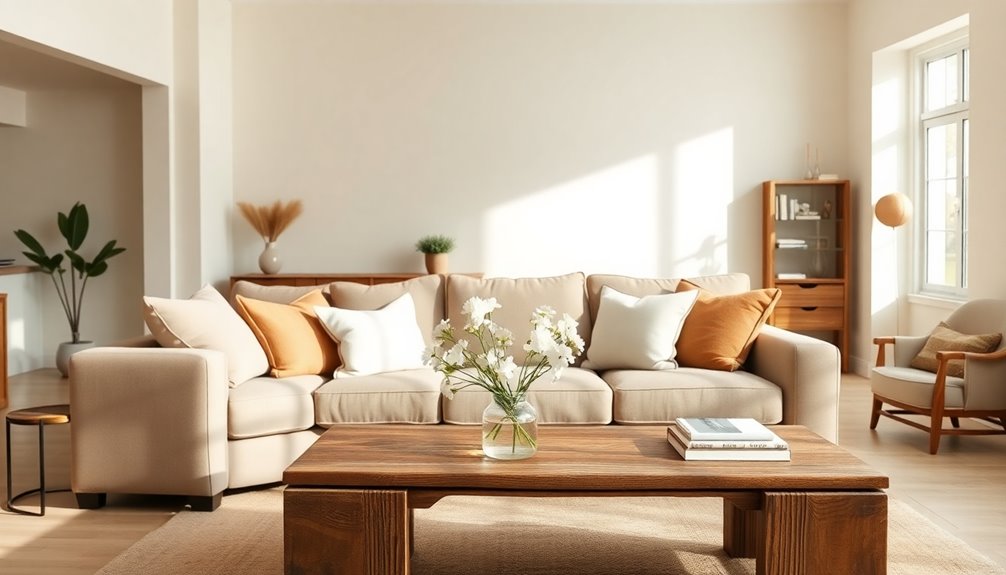
When you start with a neutral palette, you create a welcoming space that appeals to everyone in the family, regardless of age. A neutral color palette, featuring timeless tones like cream or gray, enhances brightness while promoting a cohesive design in shared areas.
This harmonious environment fosters a calming atmosphere, essential for family interaction and comfort, especially in multi-generational living. You can easily introduce seasonal decorations or pops of color against this backdrop, allowing each family member to express their style without overwhelming the overall aesthetic.
Consider using art pieces for inspiration, ensuring that your decor reflects individual preferences while maintaining that soothing neutrality, making your home a true sanctuary for all generations. Additionally, innovative interior design ideas can help you further personalize your space while keeping it inviting and inclusive.
All Together Now
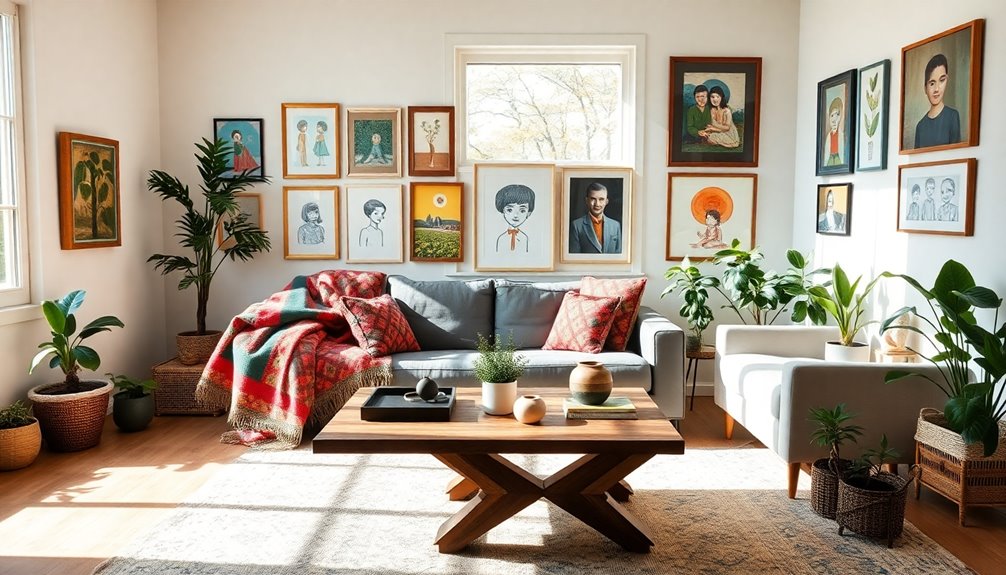
Creating spaces where everyone feels connected is essential for fostering family bonds. In multi-generational living, open floor plans encourage interaction by providing ample room for family members to gather.
Opt for multifunctional furnishings, like ottomans that double as storage space, to keep shared spaces organized and clutter-free. This not only maximizes space but also promotes a serene environment conducive to bonding.
Incorporating swivel chairs and stools allows for easy conversations across rooms, engaging family members of all ages. Additionally, sleeper sofas can accommodate guests comfortably, ensuring that family gatherings feel inclusive. Modern farmhouse style also emphasizes the importance of comfort and practicality, making it an ideal choice for multi-generational homes.
Go to Your Room
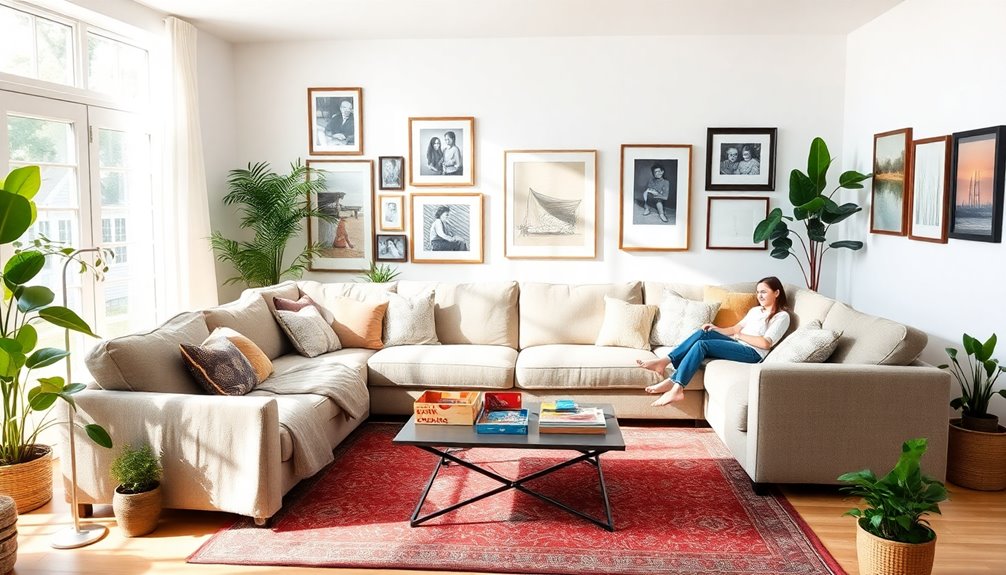
While shared spaces foster connection, personal havens in each bedroom are just as essential for maintaining family harmony.
Every family member needs their personal space to relax and recharge. You can create these individual retreats by choosing comfortable mattresses that guarantee restful sleep for everyone, promoting overall health.
Opt for neutral and versatile furnishings, making it easy to adapt as tastes evolve. Personalize each room with unique accessories and decor, reflecting individual styles and fostering a sense of ownership. Additionally, consider incorporating energy-efficient appliances which can enhance comfort and save on utility bills.
This balance between communal areas and private rooms respects each person's need for solitude, ultimately bringing everyone closer together.
Choose Inclusive Design
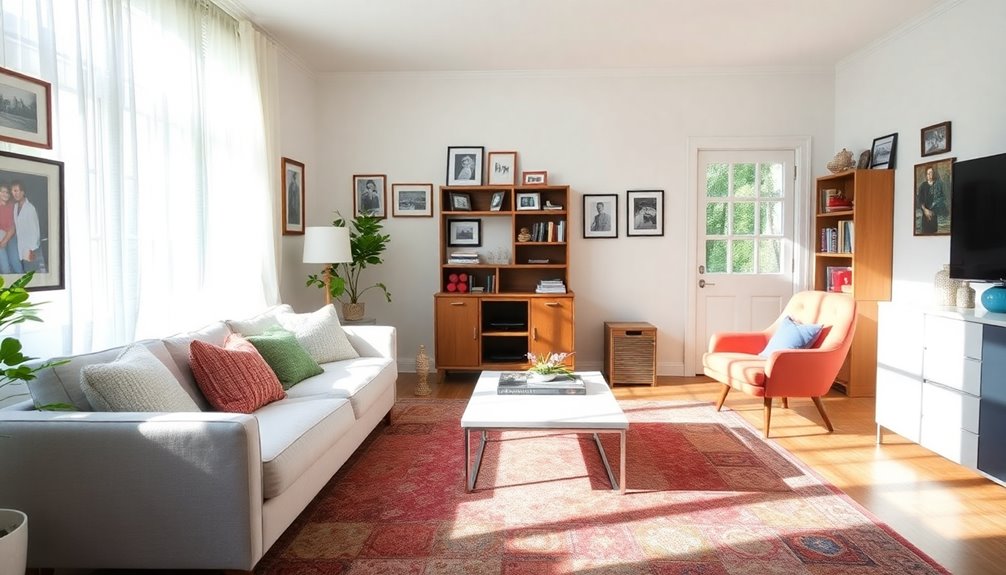
Choosing inclusive design means considering the diverse needs of everyone in your home, ensuring that all ages and abilities feel comfortable and welcomed.
In multi-generational homes, empathy in design plays an essential role in enhancing usability for family members and guests alike. Simple features like lever-style door handles, ramps, and adjustable furniture can greatly improve accessibility, making daily life easier for those with mobility challenges.
Additionally, incorporating wide doorways and clear pathways creates a safer living environment.
Remember, inclusive design doesn't sacrifice style; it promotes a harmonious blend of aesthetics and functionality. Incorporating cozy textiles can further enhance comfort for all family members in the home.
Create Memory-Making Spaces

To create memory-making spaces, focus on designing interactive gathering areas that spark connection among family members.
Incorporate family traditions into your decor, showcasing heirlooms or artwork that tell your story.
Design Interactive Gathering Areas
Creating interactive gathering areas is essential for fostering connections among family members of all ages. By designing multi-generational living spaces, you encourage engagement through shared experiences.
Here are three key elements to reflect upon:
- Flexible Furniture: Use modular sofas and movable tables to adapt to various gatherings, making it easy for everyone to join in on activities.
- Versatile Features: Incorporate a large dining table for shared meals and cozy seating for conversations, promoting collaboration among generations.
- Engaging Design: Utilize vibrant colors, textures, and communal games to inspire interaction, ensuring the space feels welcoming. Additionally, consider incorporating farmhouse-style lighting fixtures to enhance the ambiance and create a cozy atmosphere.
These memory-making spaces, enriched with elements that reflect family traditions, strengthen emotional ties and create lasting connections.
Incorporate Family Traditions Decor
While incorporating family traditions into your decor, you not only enhance your home's aesthetic but also deepen connections among generations.
Design multi-generational living spaces that celebrate your family's unique history. Create designated zones for activities like game nights or storytelling, encouraging bonding across age groups.
Flexible furniture arrangements can adapt to various gatherings, making it easy to uphold family traditions. Display heirlooms and photographs in communal areas to spark conversations about heritage, reinforcing emotional ties.
Consider adding a special area for holiday decorations where everyone can participate, promoting collaboration and shared experiences. Additionally, integrating natural materials like wood and stone into your design can further enhance the warmth and comfort of your living space.
Better Bathrooms
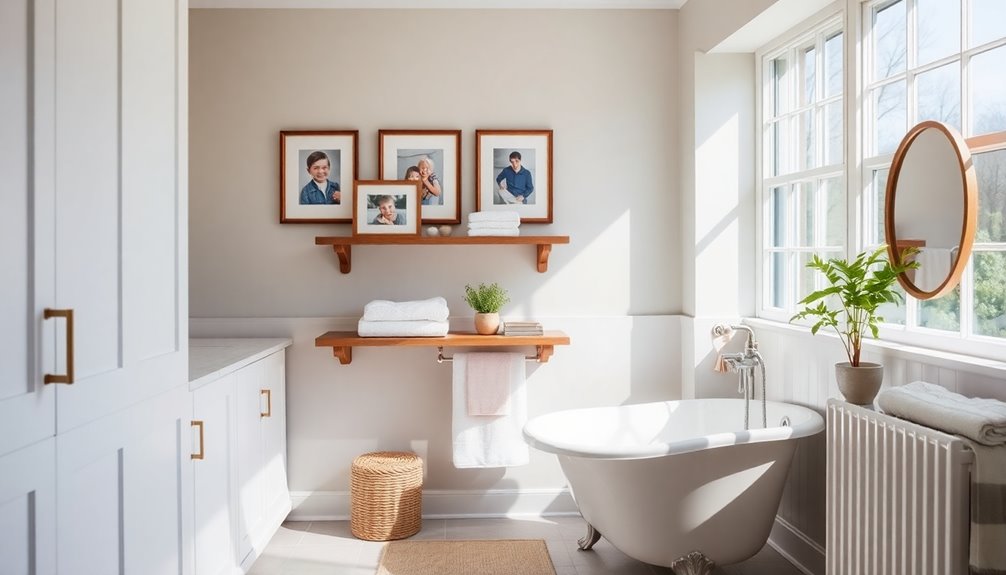
Better bathrooms in a multi-generational household can greatly enhance comfort for everyone. Here are three essential updates to take into account:
- Grab-bars: Install grab-bars near tubs and toilets to provide support for all ages, especially older family members.
- Walk-in showers: Replace traditional tubs with walk-in showers to reduce slip hazards and improve accessibility for everyone.
- Handheld shower heads: Use handheld shower heads to assist individuals with mobility restrictions, allowing for greater independence during bathing.
These features not only enhance safety but also create a more inviting space for your family. Additionally, considering the best interests of the child can help in designing a family-friendly environment that is welcoming for all generations.
A Connected Kitchen
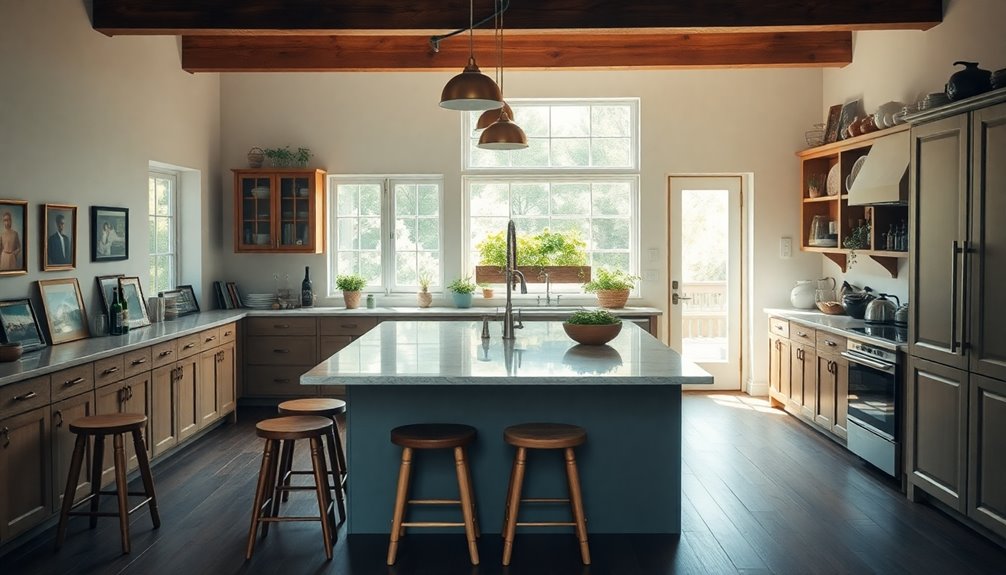
Creating a connected kitchen starts with accessible countertop heights that everyone can use comfortably.
By integrating smart appliances, you can make meal prep easier and encourage collaboration among family members. This integration can include smart home devices that facilitate remote control and energy monitoring, enhancing your kitchen's functionality.
With these changes, your kitchen becomes a welcoming space where generations can cook and connect together.
Accessible Countertop Heights
Accessible countertop heights can transform your kitchen into a space where everyone feels included and capable.
By accommodating various ages and abilities, you create a welcoming environment that promotes ease of use.
Here are three ways to implement this idea:
- Design countertops at multiple heights to cater to children, adults, and seniors.
- Consider motorized countertops that adjust with ease, allowing everyone to access the workspace comfortably.
- Incorporate a mix of surfaces for varied functions, such as prep areas and baking stations.
These features not only enhance the functionality of your multi-generational living spaces but also foster collaboration and interaction, making the kitchen a true hub for family togetherness.
Smart Appliance Integration
As families become more connected through technology, integrating smart appliances in the kitchen can enhance collaboration and streamline daily tasks.
These smart appliances can include digital message boards that facilitate seamless communication among family members, making meal preparation and scheduling much easier. When living together in a multi-generational household, everyone can stay informed and engaged through shared reminders and notes.
You might also consider a low-tech message center, like a dry-erase whiteboard, to promote organization. Additionally, a large paper calendar can help track schedules and guarantee everyone's on the same page. Moreover, using smart home devices can significantly improve home security and provide peace of mind for all generations living under one roof.
Collaborative Cooking Spaces
While a kitchen often serves as the heart of the home, designing a collaborative cooking space can transform it into a hub of connection for all generations.
By creating an environment where families living together can work together, you encourage shared experiences and bonding.
Here are three essential elements to contemplate:
- Varying Counter Heights: This guarantees everyone, regardless of age or ability, can participate in meal prep.
- Digital Message Boards: These enhance communication, helping family members coordinate schedules and recipes effortlessly.
- Communal Dining Areas: Including a space for shared meals fosters storytelling and strengthens family bonds.
With these features, your kitchen becomes more than just a cooking area; it evolves into a vibrant space for collaboration and connection. Additionally, incorporating energy-efficient ceiling fans can help maintain a comfortable environment while cooking and dining together.
Safer Stairs and Doorways

Creating a safe home environment is essential for everyone, especially when it comes to stairs and doorways.
To enhance accessibility, place at least one bedroom with an attached bathroom on the main floor, helping older adults and those with mobility challenges.
You can make your stairs safer by painting bannisters in contrasting colors for better visibility and creating a three-foot landing area at the top, allowing individuals to pause and assess their next steps.
Widen doorways to at least 40 inches to accommodate wheelchairs and guarantee emergency personnel can enter easily.
Implement smart home technology, like automatic lighting in hallways and staircases, to improve visibility during nighttime navigation.
These adjustments can greatly enhance safety and comfort for all generations in your home.
Adding Safety Features
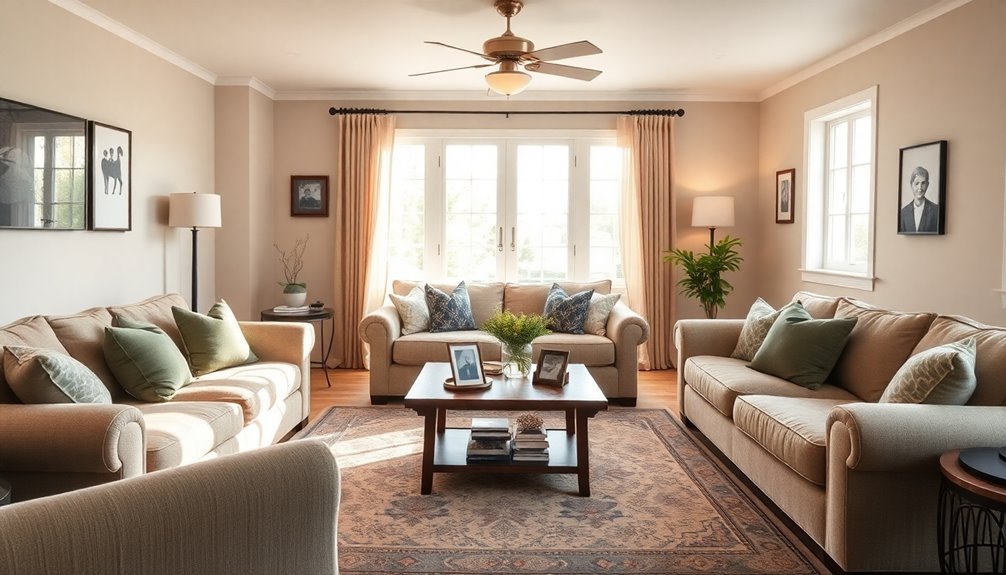
Enhancing safety features in your home goes hand in hand with making stairs and doorways more accessible. By prioritizing these elements, you can create a safer environment for older family members and everyone else.
Here are three key additions to take into account:
- Non-slip flooring: Install in high-traffic areas to reduce fall risks.
- Bright lighting: Illuminate hallways and staircases for better visibility.
- Smart home technology: Implement security systems and fall detection devices for quick responses in emergencies.
Regular maintenance of safety features, like grab bars and smoke detectors, guarantees they're reliable.
Plus, prominently displaying emergency contact information can aid in swift communication during a crisis.
Together, these steps can greatly improve your home's safety for all generations.
Enhancing Accessibility

How can you make your home more accommodating for everyone? Start by guaranteeing all entry points are wheelchair accessible, which promotes inclusivity in your multi-generational home.
Installing ramps where needed enhances accessibility, allowing for safe movement for those using mobility aids.
Switch to lever-style door handles that are easier to operate for individuals with limited hand strength, making daily interactions smoother.
Keep pathways clear of obstacles; this prevents accidents and guarantees easy navigation for all ages.
Finally, consider adjustable furniture that caters to different needs and heights, creating a comfortable and functional living space for each family member.
These changes not only improve accessibility but also foster a sense of belonging for everyone under your roof.
Promoting Family Interaction
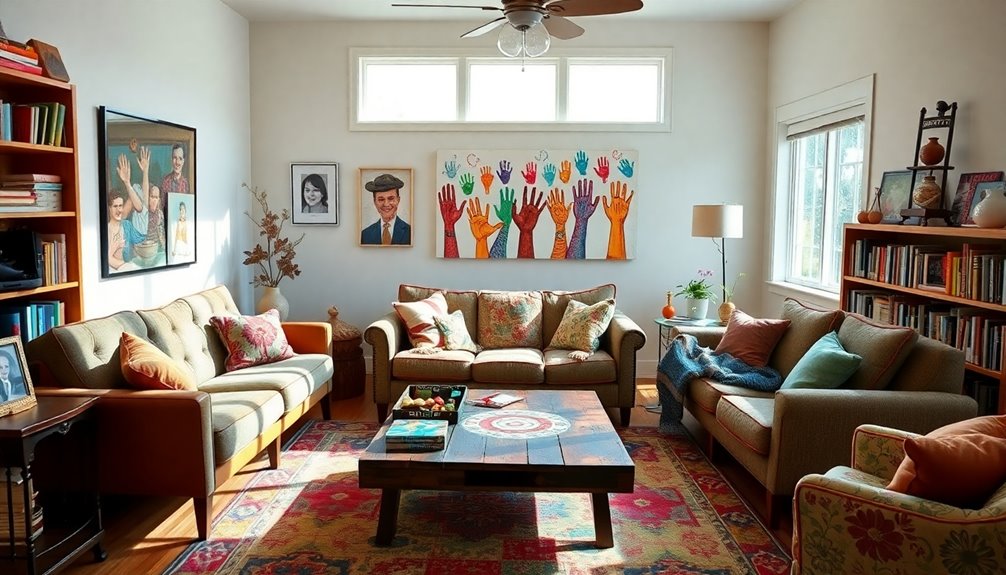
To foster meaningful connections among family members, consider designing open spaces that encourage gatherings and activities.
These living spaces can be the heart of your home, promoting interaction across generations.
Here are three ways to create an inviting environment:
- Incorporate communal dining areas: Shared meals strengthen family bonds and create lasting memories.
- Use flexible furniture arrangements: Adapt your setup for various group sizes, making it easy to celebrate or enjoy casual get-togethers.
- Designate areas for games and entertainment: Engage all generations, encouraging fun participation in family activities.
Frequently Asked Questions
What Includes Several Generations Living Under One Roof?
When several generations live under one roof, you create a unique dynamic that blends experiences and perspectives.
You'll find shared responsibilities, from childcare to household chores, which can strengthen family bonds. This arrangement often leads to improved financial stability, as family members pool resources.
However, it's crucial to maintain open communication to address privacy concerns and differing lifestyles. Embracing each generation's values can foster a harmonious living environment for everyone involved.
What Is It Called When Multiple Generations Live Together?
When multiple generations live together, it's called multi-generational living. This arrangement includes grandparents, parents, and children cohabiting, fostering strong family bonds and shared responsibilities.
You might find this setup beneficial, especially with rising housing costs and economic pressures. It allows for emotional support and caregiving across generations, enhancing everyone's well-being.
In many cultures, this living style is cherished, promoting close-knit family dynamics and shared experiences that enrich daily life.
Which Type of Family Includes Multiple Generations Living Together Under One Roof?
The type of family that includes multiple generations living together under one roof is called a multi-generational family.
You'll find this arrangement growing in popularity, especially as families seek economic relief and emotional support.
In these households, grandparents, parents, and children share not just living space, but care responsibilities and financial burdens.
This setup fosters stronger family bonds, creating a support network that benefits everyone involved and enhances the overall family experience.
What Consists of Adults From Multiple Generations of a Family Living Under One Roof?
When adults from multiple generations live under one roof, you're seeing a blend of experiences and lifestyles. This arrangement often includes grandparents, parents, and children sharing daily life, responsibilities, and support.
You'll find strong family bonds developing as each generation contributes unique perspectives. It's essential to communicate openly and establish boundaries to guarantee harmony, making your multi-generational home a nurturing environment for everyone involved.
Embracing this dynamic can enhance your family's emotional well-being.
Conclusion
By blending generations under one roof, you're crafting a vibrant tapestry of memories and connections. Embrace a neutral palette, promote accessibility, and design spaces that invite interaction. Think of your home as a tree, with each branch representing a unique family member—when nurtured, they flourish together. With these decor tips, you're not just creating a beautiful space; you're fostering a nurturing environment that celebrates the essence of family across all ages.









